Welcome to the Food and Culture course of the Diploma in Cookery Level 5 with Internship.
There is one written assessment, to be submitted to Turnitin by the date shown on your planner. In this assessment, we analyse the link between what we as societies do and the food we eat. We look at the different factors which influence what we put on our plates and which ingredients we seek out at the supermarket, and how these have changed over time.
Your tutor will remind you and advise you of the cut-off time for submission.
Food and Culture examines how what we eat is influenced by different cultural factors, and shows that what we consider our traditional or staple ingredients and dishes change over time through activities such as migration, war, travel, social media etc. and how other human cultural and societal activities such as religion, food production technology, geography and climate influence what we eat.
The second part of the assessment examines the journey of a well-known chef: their formative influences, their training and mentors, their rise to success in the food industry. There are many inspiring stories of successful chefs and many interesting resources to use to research this topic.
Before we can look at the influence of cultural factors on food, we should get an understanding of what this important but vague term actually means.
Here is a dictionary definition:
(Culture, n.d.)
So when we think about food in all its different aspects, how does this definition help us find a relationship between our “way of life”, or “general customs and beliefs”? (Culture, n.d.)
Exercise 1
Forum Activity
In groups, discuss what the term “culture” means to you – you can be as general or specific as you like to help you understand the word. Use online resources to help clarify your thinking and to give you some examples.
After your group and class discussions on the topic, write a short paragraph describing what the word “culture” means to you.
Culture, in all its various forms, and food are well recognised as being very closely linked. Like oxygen and water, food is one of the most fundamental and important of human needs, but it goes far beyond just the nourishment we need to keep our bodies alive. Food has become something we consume for the pleasure of eating, we share with friends and family, we share with our communities and with guests.
We are what we eat?
The relationship we have with food is central to our identities. It is complex, and has also been described as multidimensional. The diagram below attempts to demonstrate this.
Exercise 2
Have a go at explaining in your own words the part that food plays in shaping our identities.
The Omnivore's Paradox
Humans live in every habitable area of the planet: unlike many animals who rely on specific types of foods to receive their nutritional needs, we have evolved to be adaptable to whatever is available to eat. As omnivores, a certain amount of variety in the food we eat is essential for good health. We need proteins, carbohydrates, and fats to obtain the energy, vitamins, and minerals that our bodies need to function. We have a natural drive for novelty and variety in what we eat, which has served us well as we migrated into new regions and needed new food sources.
BUT! This isn't always a great idea. Would you eat these foods? Should you?
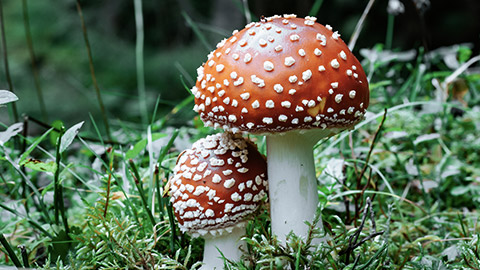
The fly cap mushroom can be deadly if ingested or can create hallucinogenic experiences.
At the same time as being naturally curious, we're also naturally suspicious. This is the omnivore's parados: both instincts (novelty/variety seeking, and resistance to new things) are important for survival in new environments. We experience curiosity; and disgust and/or fear towards new foods at the same time. The first time we eat the red mushroom, we never know if it's going to be harmless or dangerous.
Exercise 3
Just for fun, have a try of this quiz and see if you can reach the end without eating something toxic.
Exercise 4
Anyone who has ever traveled knows the thrill of experiencing new food. But your delicious might be someone else's disgusting. Take a moment to complete this quiz and think of the following:
- Have you tried any of these?
- Would you try them?
- Some of these don't look very appetizing - how does the omnivore's paradox help explain why they exist as cultural dishes?
Cultural responses to food are one way that we manage the contradiction of survival instincts (try it/avoid it). Cultural foods develop from what safe foods are available in an environment, what safe ways there are to store and prepare the food, and of course, what to avoid. Humans being social animals, these practical elements of survival become a part of our belief systems, how we make sense of the world, and therefore part of our identities. The food we eat reflects our history, lifestyle, beliefs and dietary wisdom. Selecting, preparing and sharing food together meets psychological, social, economic, cultural, and biological human needs.
Self-Directed Learning
In your journal, make a note of the foods that are culturally important to you. The make a note of some things that wouldn’t be acceptable as food in your culture. Why do you think this is so?
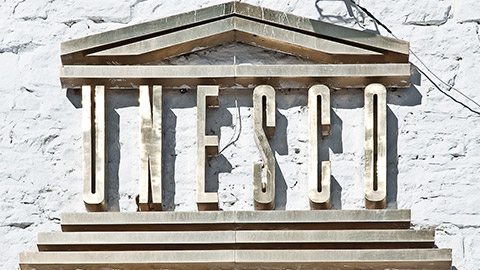
UNESCO (the United Nations Educational, Scientific and Cultural Organisation) is an agency of the United Nations. Its aim is to encourage co-operation between nations in the fields of culture, education and science, with the goal of promoting global security and peace. As part of its activities, UNESCO has also recognised the important role food plays in culture, and strives to promote and protect many different cultural aspects of food, along with other forms of culture is shown. You can see the detailed documentation of their activities on the official website: Intangible Cultural Heritage
Exercise 5
Read this article describing some of the food cultures UNESCO is trying to preserve, UNESCO Food Culture: 25 Amazing Culinary Traditions Around the World.
Choose one of the 23 listed foods described and research them in more detail. Try to find out more about the history of the food, who and where it was made, how it is made, where in the world those dishes can now be found outside of the home culture etc.
Prepare a 2-minute oral presentation to describe the food and its cultural significance. Record yourself and upload your video to the forum for your classmates to view.
Self-Directed Learning
In your journal, choose a dish from your cultural background, and outline the history of it.
‘Around the world’ sections will occur regularly across this module. They will be extremely useful for you in researching and preparing for your assessment.
Each one will have a slightly different focus and will include guidance for you to help focus your research. Allow up to 2 hours for each one (this includes your SDL for the day).
Mexico
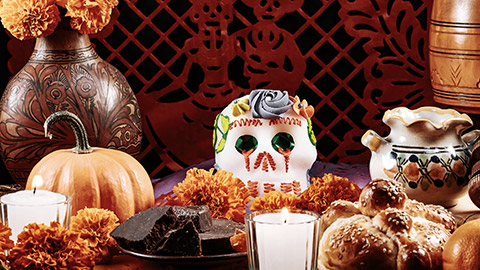
- Identify any distinct food areas within Mexico
- Which foods are associated with regional and national Mexican identity?
- What are the most common kinds of dishes in Mexican cuisine?
- Are there any foods or dishes that non-Mexicans would find strange or exotic?
- Can you identify any instances where the omnivore’s paradox might have been a factor in Mexican cultural foods?
- If possible, try making a Mexican dish at home.
The way that food is prepared and consumed becomes part of the social structure of a culture. Some aspects of this can be seen in cultural dietary laws, meal patterns and cycles and the symbolic use of food.
Watch
Meal Patterns
A meal pattern is a culturally determined set of ‘rules’ that defines:
- When eating happens (name of meal, time of day, seasonal differences)
- The format of the meal (size, type of food, amount of food, sequence of food, combinations of food, formal or informal)
- Who eats and where the eating happens (social hierarchies, locations)

Culture: Pakeha of British origin
- Number of meals per day: 3 main meals, plus morning and afternoon tea
- Timing of meals: breakfast 7-9 am; morning tea 10.30 am; lunch 12.30-1.30 pm; afternoon tea 3.30 pm; dinner 6-8 pm
- Seasonal patterns: none • Size of meal: breakfast small; lunch small; dinner large
- Type of food served at each meal: breakfast cereal, bread, dairy products; lunch salad, bread, small serve of protein; dinner large serve of protein, vegetables, starchy carbohydrates like potato, rice, pasta
- Sequence of food: cereal is a morning food, sweets come after savoury
- Combinations of food: mixing starchy carbohydrates such as potato and rice is seen as odd
- Social patterns around eating: casual, no differences around age or gender, sometimes as a group, sometimes separately
- Where the meal is eaten: in the past at the family table, but in front of the TV is now very common
Exercise 6
Research meal patterns around the world. Compare the meal patterns from two different cultures. Use the headings from the table below and post them to the student forum.
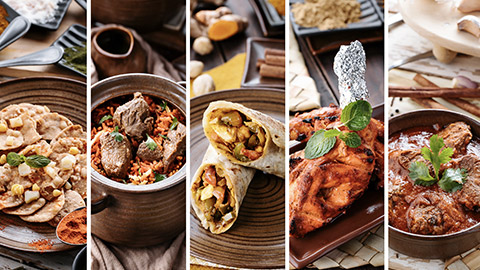
| Category | Detail |
|---|---|
| Culture: | |
| Number of meals per day: | |
| Timing of meals: | |
| Seasonal patterns: | |
| Size of meal: | |
| Type of food served at each meal: | |
| Sequence of food: | |
| Combinations of food: | |
| Social patterns around eating: | |
| Where is the meal eaten: |
Foods can have symbolic meanings attached to them based on relation to things like use, time of year and the amount of effort to obtain and prepare the food. These physical actions begin to have emotional and psychological significance attached to them. Some foods have social status attached to them, either wealth/power or lack of wealth/power. In upcoming lessons, we’ll look at specific symbolic uses of food associated with celebrations and religion.
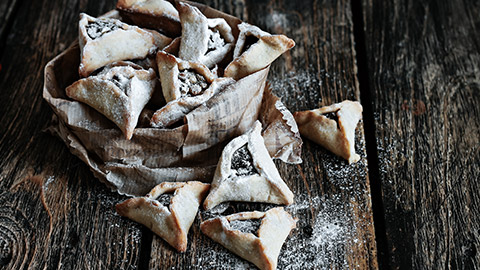
Hamantash = Enemy ears
During the Jewish holiday of Purim, the Chosen People celebrate escaping persecution by eating these sweet pastries filled with apricots, prunes, and other deliciousness. They're shaped triangularly to represent the ears of Haman -- the bad guy in the Purim story. (Kryza, 2014)
Exercise 7
Find five different foods, from five different cultures around the world that have a symbolic meaning attached to them. You should outline:
- What the food is and what it has come to symbolise
- Who it is symbolic for (the whole culture, subsets of the culture)
- When it is important (the season, time of year)
- Why it has become symbolic
Exercise 8
Just for fun, have a go at this quiz.
Self-directed learning
In your journal, explain the meal patterns from your own cultural background. Does your family have any specific practices? Then outline 2-3 foods that have symbolic meaning from your cultural background. Say what they are, and why? When researching the story of these foods, did you learn anything you didn’t know?
‘Around the world’ sections will occur regularly across this module. They will be extremely useful for you in researching and preparing for your assessment.
Each one will have a slightly different focus, and will include guidance for you to help focus your research. Allow up to 2 hours for each one (this includes your SDL for the day).
Jamaica
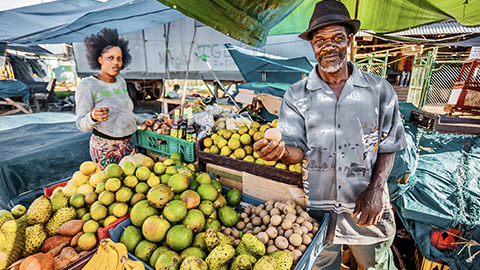
- Identify any distinct food areas within Jamaica,
- Which foods are associated with regional and national Jamaican identity?
- What are the most common kinds of dishes in Jamaican cuisine?
- Are there any foods or dishes that non-Jamaicans would find strange or exotic?
- What meal patterns and food symbolism are associated with Jamaican culture?
- If possible, try making a Jamaican dish at home
